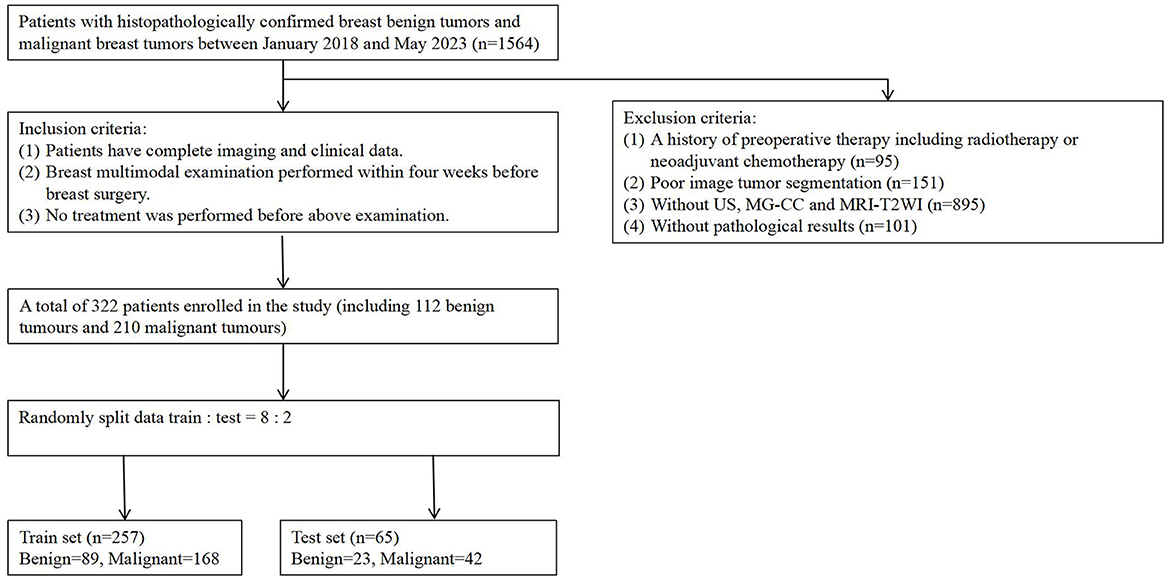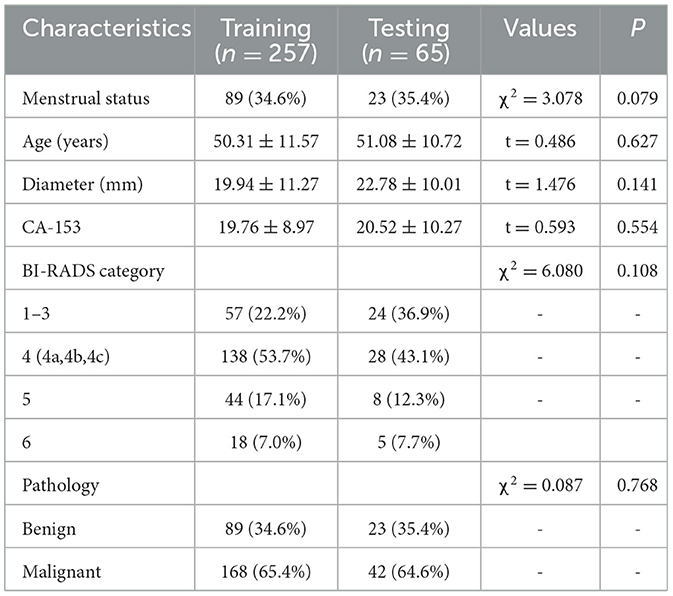- 1College of Medicine and Biological Information Engineering, Northeastern University, Shenyang, Liaoning, China
- 2Department of Nuclear Medicine, General Hospital of Northern Theater Command, Shenyang, Liaoning, China
- 3Department of Radiology, Cancer Hospital of China Medical University, Liaoning Cancer Hospital and Institute, Shenyang, Liaoning, China
- 4Department of Ultrasound, Beijing Shijitan Hospital, Capital Medical University, Beijing, China
- 5Biomedical Engineering, Shenyang University of Technology, Shenyang, Liaoning, China
A Corrigendum on
Deep learning radiomics based on multimodal imaging for distinguishing benign and malignant breast tumours
by Lu, G., Tian, R., Yang, W., Liu, R., Liu, D., Xiang, Z., and Zhang, G. (2024). Front. Med. 11:1402967. doi: 10.3389/fmed.2024.1402967
In the published article, there was an error in [Figure 1. Flowchart of patient recruitment] as published. [A total of 322 patients enrolled in the study(including 122 benign tomors and 210 malignany tumors), Train set (n = 257) Benign = 96, malignant = 161].
The corrected [Figure 1. Flowchart of patient recruitment] and its caption [Figure 1. Flowchart of patient recruitment. A total of 322 patients enrolled in the study (including 112 benign tumors and 210 malignancy tumors), with the training set (n = 257) consisting of 89 benign tumors and 168 malignant tumors.]

Figure 1. Flowchart of patient recruitment. A total of 322 patients enrolled in the study (including 112 benign tumors and 210 malignancy tumors), with the training set (n = 257) consisting of 89 benign tumors and 168 malignant tumors.
In the published article, there was an error in [Table 1, Characteristics of breast tumors in this study: in the training columns, Benign: 96(37.4%), Malignant: 161(62.6%)] as published.
The corrected [Table 1. Characteristics of breast tumors in this study. Benign: 89 (34.6%), malignant: 168 (65.4%)], and its caption [in the training columns] appears below.
In the published article, there was an error. In Section 2.1 Patient population was published with 257 patients (96 with benign breast tumours and 161 with malignant breast tumours) enrolled in the training cohort. The corrected sentence appears below: [The training cohort included 257 patients (89 with benign and 168 with malignant breast tumors)]”.
The authors apologize for this error and state that this does not change the scientific conclusions of the article in any way. The original article has been updated.
Publisher's note
All claims expressed in this article are solely those of the authors and do not necessarily represent those of their affiliated organizations, or those of the publisher, the editors and the reviewers. Any product that may be evaluated in this article, or claim that may be made by its manufacturer, is not guaranteed or endorsed by the publisher.
Keywords: deep learning, radiomics, multimodality imaging, breast tumours, deep learning radiomics, MRI, Mammography, Ultrosonography
Citation: Lu G, Tian R, Yang W, Liu R, Liu D, Xiang Z and Zhang G (2025) Correction: Deep learning radiomics based on multimodal imaging for distinguishing benign and malignant breast tumours. Front. Med. 12:1635819. doi: 10.3389/fmed.2025.1635819
Received: 27 May 2025; Accepted: 02 June 2025;
Published: 23 June 2025.
Edited and reviewed by: Minjeong Kim, University of North Carolina at Greensboro, United States
Copyright © 2025 Lu, Tian, Yang, Liu, Liu, Xiang and Zhang. This is an open-access article distributed under the terms of the Creative Commons Attribution License (CC BY). The use, distribution or reproduction in other forums is permitted, provided the original author(s) and the copyright owner(s) are credited and that the original publication in this journal is cited, in accordance with accepted academic practice. No use, distribution or reproduction is permitted which does not comply with these terms.
*Correspondence: Guoxu Zhang emhhbmdndW94dV81MDJAMTYzLmNvbQ==
 Guoxiu Lu
Guoxiu Lu Ronghui Tian1
Ronghui Tian1 Ruibo Liu
Ruibo Liu Dongmei Liu
Dongmei Liu Guoxu Zhang
Guoxu Zhang